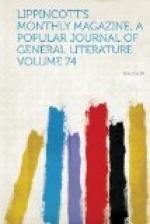mercante di campagna, who is busily engaged in receiving
and seating his numerous friends. Large droves
of young horses, and still larger herds of bullocks
and buffaloes, are assembled in a neighboring yard.
Before taking our places on the range of seats we
go to have a look at this portion of the
dramatis
personae in the coming spectacle—from
the
outside, be it understood, of a high railed
palisade, or
stazzionata, as this description
of enclosure is called in the language of the Roman
Campagna. The appearance of the animals inside,
of the buffaloes especially, does not tempt one to
make any nearer acquaintance with them. The wild
cattle of the Western prairies can hardly look wilder
or more savage. Whether the buffaloes are in
reality more savage in their temper than the other
horned cattle, or not, seems to be a doubtful question.
Some of the herdsmen say they are so: others
deny it. Possibly the former may have the more
sensitive imaginations, for unquestionably the buffalo
is a far more terrible-looking fellow than his congener.
His dark color and the form of the vicious-looking,
crumply horn in great part contribute to this.
But it seems to me that the expression of the eye produces
the same effect to a yet greater degree. The
buffalo’s eye is smaller than that of the ordinary
bull or cow, and often gleams out of the shaggy thicket
of black hair around it with a red glare that has something
truly diabolical in it. There may perhaps be collected
in the yard and in one or two enclosures near it some
forty or fifty young horses, and perhaps altogether
from a hundred to a hundred and fifty head of horned
cattle. Lounging about around these enclosures,
or looking on while the last completing touches are
given to the strong and high railing which surrounds
the space in front of the range of seats, are several
butteri and their aids, awaiting the master’s
signal for the beginning of the day’s work.
Altogether, the scene is a very strange one.
The contact of the rural and the city life, the elements
of which meet in these countries so rarely and mix
so little and so unwillingly, seems strange and incongruous.
Nothing can be wilder than all the local surroundings
of the scene; nothing less town-like than the living
things, human and other, which are to enact their
parts in it; nothing less rural, nothing more completely
of the town townish, than the assembled company of
spectators. Evidently, the individuals belonging
to either category look upon those of the other very
little in the light of fellow-creatures. In no
country in the world is the division between the town
population and that of the country so wide as it is
in Italy. No one of either class seems to be
struck by, or even to see, the extreme beauty of the
prospect from the spot on which we are standing.
It is a spot in the Campagna somewhat to the south-west
of a line drawn from the city to the base of the Alban
Hills; and though the place chosen for the operation




